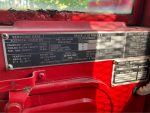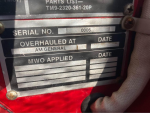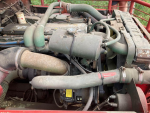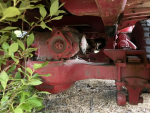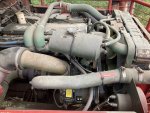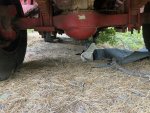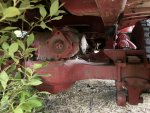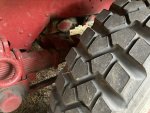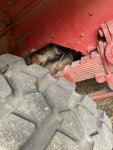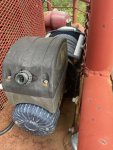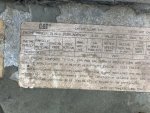So, current production trucks at the time would receive more modern updates to make their in service life go farther?
That's the basic gist, but it involved pretty much a complete rebuild. The Army and AM General recycled the good sheet metal, axles, transfer cases, beds, and frames of many existing M35s and rebuilt M35A3s out of them, with some changes to modernize the trucks to supplement FMTV distribution. One reason the ESP existed was because of concern that the FMTV would not be distributed on schedule and some units would be left without the more-modern trucks for awhile. The ESP cost 2/3 of the FMTV program at the time. It supposedly took three M35s to build two M35A3s.
About 5800 M35A3s across four variants were built between 1995 and 1998: M35A3, M35A3C, M36A3, M109A4. Anecdotally, the M35A3 seems most common, followed by the M35A3C, M109A4, and M36A3. Oddly enough some dataplates refer to the truck as the M44A3, which refers to the super-single version of the deuce from years ago (you'd think that would make it an M44A2 though

). It seems that the Army and Navy each got the A3 trucks, and some saw service in our mid-east wars. After their time with the US, some of these ended up in the mid-east in service with Lebanon. Mine was auctioned off from Fort Drum in 2010, so it seems the Army got about 15 years out of my truck! These trucks seemed to get all-new serial numbers - no serial numbers from the donor trucks seemed to remain on the frame, at least on mine.
Something that frequently comes up here: While the M35A3 has its own TMs, anything unchanged from the M35A2 is referenced in the M35A2 TMs, like body and suspension components. Anything new with the M35A3 is referenced in the M35A3 TMs.
Changes on the M35A3 include:
- The multifuel replaced with a Caterpillar 3116 rated at 170 HP and about 450 lb-ft of torque. This is the same motor used in the first FMTV run but not as powerful. It is not electronic - totally mechanical. The engines came with ether cold weather start assist. The engine compartment was lengthened and widened to, I'm guessing, make maintenance on the Cat a little easier. See how cramped the engine compartment is in the above E3 pics? It's not that cramped on the M35A3 - there's more room to work with. The hood was widened and lengthened with sheet metal, whereas later trucks got a one-piece fiberglass hood. Foam insulation was added to the underside of the hood and side panels. Both hood types came with lifting handles. The air filter was relocated to the passenger-side fender next to the exhaust pipe in an all-new case. To make more space for the bigger radiator, headlights were relocated to the fenders where the turn signals were, and the turn signals were mounted on top of the headlights.
- The 5-speed manual transmission replaced with a 4-speed Allison AT1545 automatic. Like the engine, this transmission is completely mechanical - no electronics involved. The AT1545 was likely chosen over the MT643 because it took up about the same space as the 5-speed manual, so the engine and transfer case locations didn't have to be shifted around much, if at all. The transmission has no overdrive and only allows the truck to top out at about 52 MPH, which is slightly slower than the FMTV's 55 MPH top speed.
- The axles were modified to use a Central Tire Inflation System (CTIS). A control computer (which is the only electronic thing on the truck) was added to the top of the steering column, which controlled an air manifold that regulated air pressure in all the wheels. New wheel bearings were designed to allow air to pass through the hub to the wheel (and they're rather expensive
 ). Like most current CTIS, all wheels are controlled at once - no separate inflation is possible except with an air hose attached to the emergency gladhand. Pie slice-shaped stone covers were added to the wheels to protect the wheel valves. An air dryer was also added, probably to help keep moisture out of the wheel valves.
). Like most current CTIS, all wheels are controlled at once - no separate inflation is possible except with an air hose attached to the emergency gladhand. Pie slice-shaped stone covers were added to the wheels to protect the wheel valves. An air dryer was also added, probably to help keep moisture out of the wheel valves.
- The trucks came with super singles, which all seemed to be Michelin XL 14.5R20 tires that are about 43" in diameter. The modern size is 365/80R20. These tires were somewhat directional and I think most of these trucks came with the tread facing opposite directions on each side. I chalk that up to the assembly line assembling all the wheels in the same direction. These singles use bolt-together rims which require ungodly amounts of torque to keep tight, unlike the 5-ton super single rims, which require about half the amount of torque to tighten

- Corner marker lights were added to the front and rear to the truck. Reverse lights were added to the back of the truck along with class lights.
- Split-circuit brakes
- All trucks were shipped with a cab heater with defroster ducts, a windshield washer sprayer, and turn signals.
- Air-assisted steering with a smaller steering wheel
- Two-speed electric windshield wipers
- Plastic battery box
- In-tank fuel pump removed since the Cat has an engine-driven fuel pump
- Winch-equipped models use a hydraulic winch instead of the PTO winch, which is controlled from the cab. The hydraulics were driven by a small pump off the air compressor shaft, of all things, even though the AT1545 can take a PTO-driven hydraulic pump.
- Max payload is fixed at 2 1/2 tons like how the FMTV has fixed payloads. Theoretical max payload is closer to 3 1/2 tons limited by the rims having only a 4000 lb capacity. Max towing capacity is fixed as well at 6000 lbs, but may be less limited by the strength of the automatic transmission, which can be easily overloaded, especially with the heavier M36A3.
This particular M35E3C looks like it has some of these A3 features:
- Caterpillar 3116 with components laid out similarly to the M35A3 (but that cramped engine compartment though!)
- Revised bed lighting layout, including class lights and reverse lights, and oddly enough tail lights within the rear lower bed panel like the M923 5-ton cargo truck
- Front corner marker lights
- Split-circuit brakes
- I can't tell if that's a cab heater above the doghouse. It kinda looks like one to me.
- Air-assisted steering
Alright, I'm done nerding out on the ESP

At a glance these trucks got all the upgrades from the factory that other M35 owners consider applying to their trucks. It looks like the DoD was considering such upgrades too, possibly in lieu of the FMTV program.
I hope you found that thorough review helpful!





